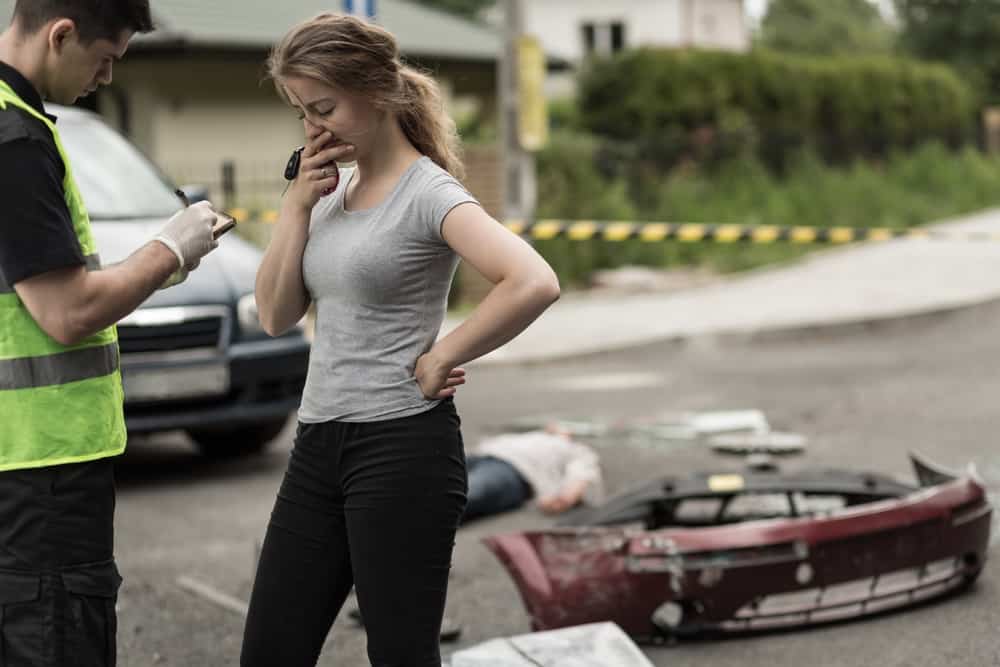Uno de los escenarios imaginables más aterradores es una colisión frontal con otro coche. Al chocar de frente, la fuerza del impacto se intensifica, y la repentina pérdida de velocidad puede ser demasiado para el cuerpo humano. Esto puede provocar algunas de las lesiones más graves en un accidente de coche, como salir despedido a través de los parabrisas y cosas peores. Si te preguntas qué puedes esperar físicamente tras un accidente de coche de este tipo, puede variar en función de las circunstancias exactas de tu accidente, pero es probable que sea necesaria cierta recuperación.
¿Cuál es el asiento más seguro del coche?
Existe cierto debate sobre si el asiento delantero o el trasero es más seguro en una colisión frontal. La sabiduría convencional ha dicho que el asiento central de la parte trasera del coche es el más seguro, ya que la persona tiene más espacio entre él y el salpicadero y las puertas, lo que le deja una mayor “zona de aplastamiento” en caso de colisión.
Sin embargo, en los modelos más recientes de automóviles, se piensa que el asiento delantero puede tener ventajas para la seguridad de los adultos. Las iniciativas de seguridad automovilística se han centrado en gran medida en el conductor y el pasajero del asiento delantero, y las características de seguridad suelen tener esto en cuenta en primer lugar. Los asientos traseros plantean el riesgo único de estar detrás de otra persona y de una silla, a menudo sin airbags.
En última instancia, lo más importante que puedes hacer para evitar lesiones por accidente de coche es utilizar cinturones de seguridad y sistemas de retención adecuados para los niños.
Lesiones comunes en colisiones frontales
Dependiendo de la velocidad y el ángulo del choque, puede haber consecuencias graves de una colisión frontal, como pasajeros aplastados bajo el salpicadero, coches que salen rodando de la carretera y pasajeros que salen despedidos de los coches. Aunque se esperan traumatismos físicos en todas las colisiones, hay ciertas lesiones que se ven con más frecuencia cuando una colisión es frontal.
Al pensar en lo que cabe esperar físicamente tras un accidente de coche, son muy frecuentes las fracturas, los cortes y laceraciones graves, las quemaduras y las lesiones y hemorragias internas. Si el coche queda aplastado de algún modo, una persona puede quedar atrapada dentro del vehículo, lo que ejerce presión sobre los órganos y permite una mayor pérdida de sangre antes de que puedan ser extraídos. A la inversa, si alguien sale despedido del vehículo, sufrirá estas lesiones durante el choque y de nuevo cuando impacte contra el suelo. Aunque algunas de ellas pueden ser leves, las versiones graves de estas lesiones pueden poner en peligro la vida.
La zona más frecuentemente lesionada en una colisión frontal es el tórax. Como el cinturón de seguridad te protege para que no salgas del vehículo, también puede ejercer presión sobre el pecho, a veces presión suficiente para romperte una costilla u otro hueso. Esta presión puede ser incluso lo bastante intensa como para provocar una hemorragia interna, lo que se conoce como síndrome del cinturón de seguridad, o lesiones musculares.
Lesiones cerebrales y de columna
Las lesiones cerebrales y vertebrales son lesiones graves y frecuentes tras un accidente de coche. Como una colisión frontal suele producirse a gran velocidad, los pasajeros son muy susceptibles de sufrir conmociones cerebrales debido al movimiento antinatural. Además, las sacudidas que sufre el cuerpo pueden hacer que la cabeza entre en contacto con el salpicadero o la ventanilla, provocando una lesión cerebral traumática. Pequeños desgarros y contusiones en el cerebro pueden provocar graves problemas más adelante. Si algo, como restos u otras piezas del coche, atraviesan el parabrisas, es posible que perforen el cráneo, dejando efectos permanentes en el pasajero.
La espalda, el cuello y la columna vertebral también son muy vulnerables. Cuando una persona es lanzada hacia delante y luego hacia atrás a velocidades antinaturales, la columna vertebral se ve forzada más allá de su capacidad normal, provocando lesiones que van de leves a graves. El latigazo cervical es muy frecuente en estas colisiones, junto con las hernias discales, las distensiones musculares y los desgarros de tejidos blandos. En casos graves, la médula espinal puede sufrir un impacto y provocar parálisis u otros efectos a largo plazo.
Secuelas de una colisión frontal
Si te has visto implicado en una colisión frontal, es probable que necesites al menos un tratamiento médico menor en el lugar del accidente. También es importante acudir a un quiropráctico tras un accidente de coche, como los especialistas de Ortopedia AICA. Estos expertos pueden ayudarte a comprender qué puedes esperar físicamente tras un accidente de coche y crear un diagnóstico y un plan de tratamiento que se ajuste a tus necesidades y objetivos. Dependiendo de tus lesiones, tu recuperación puede tener un plazo largo, pero Ortopedia AICA ofrece un equipo multidisciplinar que te ayudará a curarte de forma eficaz, segura y lo más rápidamente posible.








